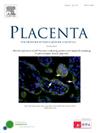NNMT在子痫前期的表达:胎盘组织和细胞系的分析。
IF 2.5
2区 医学
Q2 DEVELOPMENTAL BIOLOGY
引用次数: 0
摘要
目的:先兆子痫(PE)是一种以妊娠期新发高血压和蛋白尿为特征的多系统疾病。烟酰胺n -甲基转移酶(NNMT)是一种催化烟酰胺(NAM) n -甲基化形成1-甲基烟酰胺(MNA)和s -腺苷- l-同型半胱氨酸(SAH)的酶。本研究的目的是研究NNMT在正常胎盘和PE胎盘中的表达,并评估缺氧、氧化应激和炎症是否可以调节NNMT的表达。材料和方法:对妊娠早期、正常足月和PE胎盘进行免疫组化和Western blot检测。在缺氧、氧化应激(H2O2)和炎症(TNF-α)条件下,HTR-8/SVneo和BeWo细胞系也评估了NNMT的表达。结果:NNMT在第一、第三和PE胎盘的细胞滋养细胞和合胞滋养细胞中均有表达。内皮血管中NNMT在妊娠早期和晚期呈阳性表达,但在PE胎盘中主要呈阴性表达。从妊娠早期到妊娠晚期,NNMT的表达没有变化,但与对照组胎盘相比,PE胎盘的NNMT表达显著降低。NNMT在HTR-8/SVneo和BeWo细胞质中均有表达,其表达不受合胞作用的影响。缺氧降低了BeWo细胞中NNMT的表达,而HTR-8/SVneo细胞中NNMT的表达没有变化,氧化应激没有改变两种细胞系中NNMT的表达。TNF-α处理显著降低了两种细胞系中NNMT的表达。结论:在PE胎盘中发现的低NNMT表达可能代表了对这种疾病特征的缺氧和炎症的反应。因此,该酶可以通过保护滋养细胞免受pe诱导的损伤来促进人类胎盘的正常发育。本文章由计算机程序翻译,如有差异,请以英文原文为准。
NNMT expression in preeclampsia: Analyses on placental tissues and cell lines
Objective
Preeclampsia (PE) is a multisystem disorder characterized by new onset hypertension and proteinuria during pregnancy. Nicotinamide N-methyltransferase (NNMT) is an enzyme that catalyzes the N-methylation of nicotinamide (NAM) to form 1-methylnicotinamide (MNA) and S-adenosyl-L-homocysteine (SAH). The aim of this study was to investigate NNMT expression in normal and PE placentas, and evaluate whether hypoxia, oxidative stress and inflammation could modulate NNMT expression.
Materials and methods
Immunohistochemistry and Western blot were performed on first trimester, normal term and PE placentas. NNMT expression was also evaluated in HTR-8/SVneo and BeWo cell lines under hypoxic, oxidative stress (by H2O2) and inflammatory (by TNF-α) conditions.
Results
NNMT was expressed in cytotrophoblast and syncytiotrophoblast of first, third and PE placentas. Endothelial vessels were positive for NNMT expression in first and third trimester but mainly negative in PE placentas. NNMT expression did not change from first to third trimester but significantly decreased in PE placentas compared to control placentas. NNMT was expressed in the cytoplasm of both HTR-8/SVneo and BeWo cell lines, and its expression was not altered by syncytialization. Hypoxia decreased NNMT expression in BeWo but not HTR-8/SVneo cells while oxidative stress did not alter NNMT expression in both cell lines. TNF-α treatment significantly decreased NNMT expression in both cell lines.
Conclusions
Low NNMT expression found in PE placentas may represent a response to the hypoxia and inflammation featuring this disorder. Therefore, the enzyme could contribute to the normal human placental development, by defending trophoblast cells form PE-induced damages.
求助全文
通过发布文献求助,成功后即可免费获取论文全文。
去求助
来源期刊

Placenta
医学-发育生物学
CiteScore
6.30
自引率
10.50%
发文量
391
审稿时长
78 days
期刊介绍:
Placenta publishes high-quality original articles and invited topical reviews on all aspects of human and animal placentation, and the interactions between the mother, the placenta and fetal development. Topics covered include evolution, development, genetics and epigenetics, stem cells, metabolism, transport, immunology, pathology, pharmacology, cell and molecular biology, and developmental programming. The Editors welcome studies on implantation and the endometrium, comparative placentation, the uterine and umbilical circulations, the relationship between fetal and placental development, clinical aspects of altered placental development or function, the placental membranes, the influence of paternal factors on placental development or function, and the assessment of biomarkers of placental disorders.
 求助内容:
求助内容: 应助结果提醒方式:
应助结果提醒方式:


